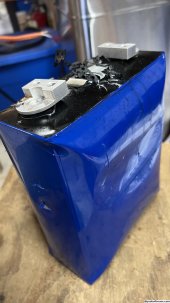I completed my DIY build(s) a few days ago. 32 Cells total, 16S, 280ah EVE Cells, JK BMS(s) B2A24S20P, Growatt 5000ES units, Solar Assistant.
All electronics appear working as designed.
My 1st 16S battery build running the past month, maybe past 30-40 days. Clean, no observed issues. JK Active balancing normal. My 2nd 16S battery build put together and online this past Friday.
All looked clean, running normal.
I walked out to the Shop (external garage) and Growatt fans noise running normally. All indications looked fine from a 6-7 ft distance. As I get closer I can smell this funky smell. Strange smell, liquid on the lower battery cells. Vented cells I believe.
Both battery banks appear as blownout/swollen/fail cells #9/#10.
Weird thing, all electronics (Growatts & JK BMS) running and reporting normal. JK units actively balancing. Growatts actively charging. No fire, but massive heat around Cells #9/#10. Those cells swollen, Cell #9 lower/Bank2 vented. No breakers tripped (Nader 125Amp) on either bank. No actual explosion.
I immediately shutdown system.
Still Assessing damage. Possibly wait until they cool down. Waiting to disconnect and evaluate.
Very lucky no fire.
Damn, damn, damn. Expensive fail.
Need to assess and decide what I did wrong. Obvisously something.
BANK-1 Upper & BANK-2 Lower (Before Event)
View attachment 170284
BANK-1 (1st Build) Before Event
View attachment 170280
BANK-1 After Event (Swelling Cell#9)
View attachment 170281
BANK-2 Lower (AFTER Event) Cell #9/#10/#11
View attachment 170285
Constructive comments appreciated, anything obvious noted?





